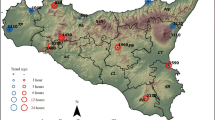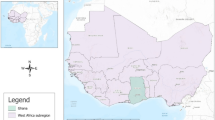Abstract
Based on hourly rainfall observational data from 442 stations during 1960–2014, a regional frequency analysis of the annual maxima (AM) sub-daily rainfall series (1-, 2-, 3-, 6-, 12-, and 24-h rainfall, using a moving window approach) for eastern China was conducted. Eastern China was divided into 13 homogeneous regions: Northeast (NE1, NE2), Central (C), Central North (CN1, CN2), Central East (CE1, CE2, CE3), Southeast (SE1, SE2, SE3, SE4), and Southwest (SW). The generalized extreme value performed best for the AM series in regions NE, C, CN2, CE1, CE2, SE2, and SW, and the generalized logistic distribution was appropriate in the other regions. Maximum return levels were in the SE4 region, with value ranges of 80–270 mm (1-h to 24-h rainfall) and 108–390 mm (1-h to 24-h rainfall) for 20- and 100 yr, respectively. Minimum return levels were in the CN1 and NE1 regions, with values of 37–104 mm and 53–140 mm for 20 and 100 yr, respectively. Comparing return levels using the optimal and commonly used Pearson-III distribution, the mean return-level differences in eastern China for 1–24-h rainfall varied from −3–4 mm to −23–11 mm (−10%–10%) for 20-yr events, reaching −6–26 mm (−10%–30%) and −10–133 mm (−10%–90%) for 100-yr events. In view of the large differences in estimated return levels, more attention should be given to frequency analysis of sub-daily rainfall over China, for improved water management and disaster reduction.
Similar content being viewed by others
References
Chen, J., Y. G. Zheng, X. L. Zhang, and P. J. Zhu, 2013: Distribution and diurnal variation of warm-season short-duration heavy rainfall in relation to the MCSs in China. Acta Meteorologica Sinica, 27(6), 868–888, doi: 10.1007/s13351-013-0605-x.
Chinese Ministry of Water Resources, 1994: GB 50201-1994 Standard for flood control. China Planning Press, 19 pp. (in Chinese)
Coles, S., 2001: An Introduction to Statistical Modeling of Extreme Values. Springer, 208 pp.
Cowpertwait, P. S. P., 2011: A regionalization method based on a cluster probability model. Water Resour. Res., 47, W11525, doi: 10.1029/2011WR011084.
Du, H., J. Xia, and S. D. Zeng, 2014: Regional frequency analysis of extreme precipitation and its spatio-temporal characteristics in the Huai River Basin, China. Natural Hazards, 70(1), 195–215.
El Adlouni, S., B. Bobée, and T. B. M. J. Ouarda, 2008: On the tails of extreme event distributions in hydrology. J. Hydrol., 355(1–4), 16–33.
Feng, S., S. Nadarajah, and Q. Hu, 2007: Modeling annual extreme precipitation in China using the generalized extreme value distribution. J. Meteor. Soc. Japan, 85(5), 599–613.
Fischer, E. M., and R. Knutti, 2015: Anthropogenic contribution to global occurrence of heavy-precipitation and hightemperature extremes. Nature Climate Change, 5(6), 560–564.
Fischer, T., B. D. Su, Y. Luo, and T. Scholten, 2012: Probability distribution of precipitation extremes for weather indexbased insurance in the Zhujiang River Basin, South China. J. Hydrometeor., 13(3), 1023–1037.
Fischer, T., B. D. Su, and S. S. Wen, 2015: Spatio-temporal analysis of economic losses from tropical cyclones in affected provinces of China for the last 30 years (1984–2013). Natural Hazards Review, 16(4), 04015010.
Fu, S. M., D. S. Li, J. H. Sun, D. Si, J. Ling, and F. Y. Tian, 2016: A 31-year trend of the hourly precipitation over South China and the underlying mechanisms. Atmos. Sci. Lett., 17(3), 216–222.
Goswami, B. N., V. Venugopal, D. Sengupta, M. S. Madhusoodanan, and P. K. Xavier, 2006: Increasing trend of extreme rain events over India in a warming environment. Science, 314, 1442–1445.
Greenwood, J. A., J. M. Landwehr, N. C. Matalas, and J. R. Wallis, 1979: Probability weighted moments: Definition and relation to parameters of several distributions expressable in inverse form. Water Resour. Res., 15(5), 1049–1054.
Groisman, P. Y., R. W. Knight, D. R. Easterling, T. R. Karl, G. C. Hegerl, and V. N. Razuvaev, 2005: Trends in intense precipitation in the climate record. J. Climate, 18, 1326–1350.
Haddad, K., and A. Rahman, 2011: Selection of the best fit flood frequency distribution and parameter estimation procedure: A case study for Tasmania in Australia. Stochastic Environmental Research and Risk Assessment, 25(3), 415–428.
Hassan, B. G. H., and F. Ping, 2012: Regional rainfall frequency analysis for the Luanhe basin-by using L-moments and cluster techniques. APCBEE Procedia, 1, 126–135.
Hosking, J. R. M, 1990: L-moments: analysis and estimation of distributions using linear combinations of order statistics. Journal of the Royal Statistical Society. Series B. Methodological, 52(1), 105–124.
Hosking, J. R. M., and J. R. Wallis, 1997: Regional Frequency Analysis: An Approach Based on L-Moments. Cambridge University Press, 242 pp.
IPCC, 2014: Summary for policymakers. Climate Change 2014: Impacts, adaptation, and vulnerability. Part A: Global and Sectoral Aspects. Contribution of Working Group II to the Fifth Assessment Report of the Intergovernmental Panel on Climate Change, C. B Field et al., Eds., Cambridge University Press, 1–32.
Jiang, T., T. Fischer, and X. X. Lu, 2013: Larger Asian rivers: changes in hydro-climate and water environments. Quaternary International, 304, 1–4.
Jiang, T., T. Fischer, X. X. Lu, and H. M. He, 2015: Larger Asian rivers: Impacts from human activities and climate change. Quaternary International, 380–381, 1–4.
Jiang, Z. H., Y. C. Shen, T. T. Ma, P. M. Zhai, and S. D. Fang, 2014: Changes of precipitation intensity spectra in different regions of mainland China during 1961–2006. Journal of Meteorological Research, 28, 1085–1098.
Kay, A. L., H. N. Davies, V. A. Bell, and R. G. Jones, 2009: Comparison of uncertainty sources for climate change impacts: Flood frequency in England. Climatic Change, 92(1–2), 41–63.
Kendall, M. G., 1970: Rank Correlation Methods. 4th ed., Griffin, New York.
Klein Tank, A. M. G., F.W. Zwiers, and X. B. Zhang, 2009: Guidelines on Analysis of Extremes in a Changing Climate in Support of Informed Decisions for Adaptation. WMO/WCDMPNo. 72, 52 pp.
Kumar, R., N., K. Goel, C. Chatterjee, and P. C. Nayak, 2015: Regional flood frequency analysis using soft computing techniques. Water Resources Management, 29(6), 1965–1978.
Li, D. S., J. H. Sun, S. M. Fu, J. Wei, S. G. Wang, and F. Y. Tian, 2016: Spatiotemporal characteristics of hourly precipitation over central eastern China during the warm season of 1982–2012. Int. J. Climatol., 36, 3148–3160, doi: 10.1002/joc.4543.
Li, J., R. C. Yu, and W. Sun, 2013: Calculation and analysis of the thresholds of hourly extreme precipitation in mainland China. Torrential Rain and Disasters, 32(1), 11–16. (in Chinese)
Liu, B. H., M. Xu, M. Henderson, and Y. Qi, 2005: Observed trends of precipitation amount, frequency, and intensity in China, 1960–2000. J. Geophys. Res., 110, D08103, doi: 10.1029/2004JD004864.
Liu, R., S. C. Shaw, R. J. Cicerone, C. J. Shiu, J. Li, J. L. Wang, and Y. H. Zhang, 2015: Trends of extreme precipitation in eastern china and their possible causes. Adv. Atmos. Sci., 32, 1027–1037, doi: 10.1007/s00376-015-5002-1.
Ma, S. M., T. J. Zhou, A. G. Dai, and Z. Y. Han, 2015: Observed changes in the distributions of daily precipitation frequency and amount over China from 1960 to 2013. J. Climate, 28(16), 6960–6978.
Madsen, H., C. P. Pearson, and D. Rosbjerg, 1997b: Comparison of annual maximum series and partial duration series methods for modeling extreme hydrologic events: 2. Regional modeling. Water Resour. Res., 33(4), 759–769.
Madsen, H., P. F. Rasmussen, and D. Rosbjerg, 1997a: Comparison of annual maximum series and partial duration series methods for modeling extreme hydrologic events: 1. At-site modeling. Water Resour. Res., 33(4), 747–757.
Mann, H. B., 1945: Nonparametric tests against trend. Econometrica, 13(3), 245–259.
Milly, P. C. D., J. Betancourt, M. Falkenmark, R. M. Hirsch, Z. W. Kundzewicz, D. P. Lettenmaier, and R. J. Stouffer, 2008: Stationarity is dead: whither water management? Science, 319(5863), 573–574.
Mladjic, B., L. Sushama, M. N. Khaliq, R. Laprise, D. Caya, and R. Roy, 2011: Canadian RCM projected changes to extreme precipitation characteristics over Canada. J. Climate, 24(10), 2565–2584.
Moore, B. J., K. M. Mahoney, E. M. Sukovich, R. Cifelli, and T. M. Hamill, 2015: Climatology and environmental characteristics of extreme precipitation events in the Southeastern United States. Mon. Wea. Rev., 143(3), 718–741.
Öztekin, T., 2007: Wakeby distribution for representing annual extreme and partial duration rainfall series. Meteorological Applications, 14(4), 381–387.
Park, J. S., H. S. Jung, R. S. Kim, and J. H. Oh, 2001: Modelling summer extreme rainfall over the Korean peninsula usingWakeby distribution. Int. J. Climatol., 21(11), 1371–1384.
Qian, W. H., J. L. Fu, and Z. W. Yan, 2007: Decrease of light rain events in summer associated with a warming environment in China during 1961–2005. Geophys. Res. Lett., 34, L11705, doi: 10.1029/2007GL029631.
Ramos, M. C., 2001: Divisive and hierarchical clustering techniques to analyse variability of rainfall distribution patterns in a Mediterranean region. Atmos. Res., 57, 123–138.
Ren, Z. H., and Coauthors, 2010: Quality control procedures for hourly precipitation data from automatic weather stations in China. Meteorological Monthly, 36(7), 123–132. (in Chinese)
Serinaldi, F., and C. G. Kilsby, 2015: Stationarity is undead: uncertainty dominates the distribution of extremes. Advances in Water Resources, 77, 17–36.
Su, B. D., Z. Kundzewicz, and T. Jiang, 2009: Simulation of extreme precipitation over the Yangtze River Basin using Wakeby distribution. Theor. Appl. Climatol., 96, 209–219.
Wallis, J. R., M. G. Schaefer, B. L. Barker, and G. H. Taylor, 2007: Regional precipitation-frequency analysis and spatial mapping for 24-hour and 2-hour durations for Washington State. Hydrology and Earth System Sciences, 11(1), 415–442.
Yang, T., Q. X. Shao, Z.-C. Hao, X. Chen, Z. X. Zhang, C.-Y. Xu, and L. M. Sun, 2010: Regional frequency analysis and spatiotemporal pattern characterization of rainfall extremes in the Pearl River Basin, China. J. Hydrol., 380(3–4), 386–405.
Yao, L., X. Q. Li, and L. M. Zhang, 2009: Spatial-temporal distribution characteristics of hourly rain intensity in China. Meteorological Monthly, 35(2), 80–87. (in Chinese)
Zhang, H., and P. M. Zhai, 2011: Temporal and spatial characteristics of extreme hourly precipitation over eastern China in the warm season. Adv. Atmos. Sci., 28, 1177–1183, doi: 10.1007/s00376-011-0020-0.
Zheng, Y., M. Xue, B. Li, J. Chen, and Z. Tao., 2016: Spatial characteristics of extreme rainfall over China with hourly through 24-hour accumulation periods based on nationallevel hourly rain gauge data. Adv. Atmos. Sci., 33(11), doi: 10.1007/s00376-016-6128-5.
Zhu, J., Y. C. Zhang, and D. Q. Huang, 2009: Analysis of changes in different-class precipitation over eastern China under global warming. Plateau Meteorology, 28(4), 889–896. (in Chinese)
Zhu, Q., X. Xu, C. Gao, Q. H. Ran, and Y. P. Xu, 2015: Qualitative and quantitative uncertainties in regional rainfall frequency analysis. Journal of Zhejiang University-Science A (Applied Physics and Engineering), 16(3), 194–203.
Zou, X. K., and F. M. Ren, 2015: Changes in regional heavy rainfall events in China during 1961–2012. Adv. Atmos. Sci., 32(5), 704–714, doi: 10.1007/s00376-014-4127-y.
Acknowledgements
This research was supported by the National Basic Research (973) Program of China (Grant Nos. 2013CB430205 and 2012CB955903), and the National Natural Science Foundation of China (Grant Nos. 41171406, 41375099, 41561124014 and 91337108). We thank the National Meteorological Information Center for providing the hourly rainfall data. We also thank the anonymous reviewers for providing useful suggestions to improve this manuscript.
Author information
Authors and Affiliations
Corresponding author
Rights and permissions
About this article
Cite this article
Sun, H., Wang, G., Li, X. et al. Regional frequency analysis of observed sub-daily rainfall maxima over eastern China. Adv. Atmos. Sci. 34, 209–225 (2017). https://doi.org/10.1007/s00376-016-6086-y
Received:
Revised:
Accepted:
Published:
Issue Date:
DOI: https://doi.org/10.1007/s00376-016-6086-y




